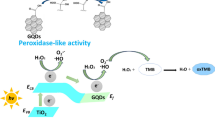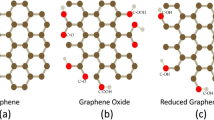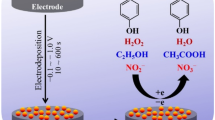Abstract
We report on the single-step preparation of a composite consisting of graphene oxide (GO), Prussian blue (PB) and chitosan (Chit) that was deposited on a glassy carbon electrode and then used to determine hydrogen peroxide. The composite was obtained by mixing GO, Chit, potassium ferricyanide and ferric chloride and keeping it at 90 °C for 1 h. This method is simple and inexpensive, and does not require purification, centrifugation or sedimentation. Scanning electron microscopy, UV-vis spectroscopy, Fourier transform IR spectroscopy and X-ray diffraction were used to characterize the GO-PB-Chit composites and revealed that PB nanoparticles were formed and uniformly distributed on the surfaces of the GO due to the integrating effects of Chit and GO. The composite displayed electrocatalytic activity in the reduction of hydrogen peroxide to which it responded with good linear relationship in the 1.0 μM to 1.0 mM concentration range, with a detection limit of 0.1 μM (at S/N = 3).

One-step preparation of graphene oxide (GO)-Prussian blue (PB)-chitosan (Chit) composites for H2O2 detection is reported. This method is simple and low-cost, and can be completed by the one-step process without further process like purification, centrifugation and sedimentation






Similar content being viewed by others
References
Novoselov KS, Geim AK, Morozov SV, Zhang Y, Dubonos SV, Grigorieva IV, Firsov AA (2004) Electric field effect in atomically thin carbon films. Science 306:666–669
Avouris P, Chen ZH, Perebeinos V (2007) Carbon-based electronics. Nat Nanotechnol 2:605–615
Lee C, Wei XD, Kysar J, Hone J (2008) Measurement of the elastic properties and intrinsic strength of monolayer graphene. Science 321:385–388
Zuo XL, He SJ, Li D, Peng C, Huang Q, Song SP, Fan CH (2010) Graphene oxide-facilitated electron transfer of metalloproteins at electrode surfaces. Langmuir 26:1936–1939
Margarita HA, Ahmed AA, Michael JM, Ilhan AA, Robert KP (2007) Intercalation and stitching of graphite oxide with diaminoalkanes. Langmuir 23:10644–10649
Bissessur R, Liu KY, White W, Scully SF (2006) Encapsulation of polyanilines into graphite oxide. Langmuir 22:1729–1734
Huang J, Zhang LM, Chen B, Ji N, Chen FH, Zhang Y, Zhang ZJ (2010) Nanocomposites of size-controlled gold nanoparticles and graphene oxide: formation and applications in SERS and catalysis. Nanoscale 2:2733–2738
Xu C, Wang X, Zhu J, Yang X, Lu L (2008) Deposition of Co3O4 nanoparticles onto exfoliated graphite oxide sheets. J Mater Chem 18:5625–5629
Keggin JF, Miles FD (1936) Structures and formulas of the Prussian blues and related compounds. Nature 137:577–578
Ellis D, Eckhoff M, Neff VD (1981) Electrochromism in the mixed-valence hexacyanides. 1. Voltammetric and spectral studies of the oxidation and reduction of thin-films of Prussian blue. J Phys Chem 85:1225–1231
Leventis N, Chung YC (1992) New complementary electrochromic system based on poly(pyrrole)-Prussian blue composite, a benzylviologen polymer, and poly(vinylpyrrolidone)/potassium sulfate aqueous electrolyte. Chem Mater 4:1415–1422
DeLongchamp DM, Hammond PT (2004) High-contrast electrochromism and controllable dissolution of assembled Prussian blue/polymer nanocomposites. Adv Funct Mater 14:224–232
Sato O, Einaga Y, Iyoda T, Fujishima A, Hashimoto K (1999) Photoinduced long-range magnetic ordering of a cobalt-iron cyanide. Inorg Chem 38:4405–4412
Ruiz E, Rodriguez-Fortea A, Alvarez S, Verdague M (2005) Is it possible to get high TC magnets with Prussian blue analogues? A theoretical prospect. Chem-Eur J 11:2135–2144
Karyakin AA, Karyakina EE, Gorton L (1999) On the mechanism o f H2O2 reduction at Prussian blue modified electrodes. Electrochem Commun 1:78–82
Karyakin AA, Karyakina EE, Gorton L (2000) Amperometric biosensor for glutamate using Prussian Blue based “artificial peroxidase” as a transducer for hydrogen peroxide. Anal Chem 72:1720–1723
Zhao G, Feng JJ, Zhang QL, Li SP, Chen HY (2005) Synthesis and characterization of Prussian blue modified magnetite nanoparticles and its application to the electrocatalytic reduction of H2O2. Chem Mater 17:3154–3159
Zhang K, Zhang N, Cai H, Wang C (2012) A novel non-enzyme hydrogen peroxide sensor based on an electrode modified with carbon nanotube-wired CuO nanoflowers. Electrochim Acta 176:137–142
Wang QX, Zhang HL, Wu YW, Yu AM (2012) Amperometric hydrogen peroxide biosensor based on a glassy carbon electrode modified with polythionine and gold nanoparticles. Electrochim Acta 176:279–285
Zhong HA, Yuan R, Chai YQ, Zhang Y, Wang CY, Jia F (2012) Non-enzymatic hydrogen peroxide amperometric sensor based on a glassy carbon electrode modified with an MWCNT/polyaniline composite film and platinum nanoparticles. Electrochim Acta 176:389–395
Wang YL, Tang M, Lin XH, Gao F, Li MG (2012) Sensor for hydrogen peroxide using a hemoglobin-modified glassy carbon electrode prepared by enhanced loading of silver nanoparticle onto carbon nanospheres via spontaneous polymerization of dopamine. Electrochim Acta 176:405–410
Habibi B, Jahanbakhshi M, Pournaghi-Azar MH (2012) Voltammetric and amperometric determination of hydrogen peroxide using a carbon-ceramic electrode modified with a nanohybrid composite made from single-walled carbon nanotubes and silver nanoparticles. Electrochim Acta 177:185–193
Schäferling M, Grögel DBM, Schreml S (2011) Luminescent probes for detection and imaging of hydrogen peroxide. Electrochim Acta 174:1–18
Qiu JD, Xiong M, Liang RP, Zhang J, Xia XH (2008) In situ synthesis and characterization of multi-walled carbon nanotube/Prussian blue nanocomposite materials and application. J Nanosci Nanotechnol 8:4453–4460
Jin E, Lu XF, Cui LL, Chao DM, Wang C (2010) Fabrication of graphene/prussian blue composite nanosheets and their electrocatalytic reduction of H2O2. Electrochim Acta 55:7230–7234
Cao LY, Liu YL, Zhang BH, Lu LH (2010) In situ controllable growth of Prussian blue nanocubes on reduced graphene oxide: facile synthesis and their application as enhanced nanoelectrocatalyst for H2O2 reduction. ACS Appl Mater Interfaces 2:2339–2346
Jiang YY, Zhang XD, Shan CS, Hua SH, Zhang QX, Bai XX, Dan L, Niu L (2011) Functionalization of graphene with electrodeposited Prussian blue towards amperometric sensing application. Talanta 85:76–81
Zhang Y, Sun XM, Zhu LZ, Shen HB, Jia NQ (2011) Electrochemical sensing based on graphene oxide/Prussian blue hybrid film modified electrode. Electrochim Acta 56:1239–1245
Liu XW, Yao ZJ, Wang YF, Wei XW (2010) Graphene oxide sheet-prussian blue nanocomposites: green synthesis and their extraordinary electrochemical properties. Colloids Surf B 81:508–512
Zhang MG, Smith A, Gorshi W (2004) Carbon nanotube-chitosan system for electrochemical sensing based on dehydrogenase enzymes. Anal Chem 76:5045–5050
Qian L, Yang XR (2006) Composite film of carbon nanotubes and chitosan for preparation of amperometric hydrogen peroxide biosensor. Talanta 68:721–727
Ding Y, Hu YL, Gu G, Xia XH (2009) Controllable synthesis and formation mechanism investigation of Prussian blue nanocrystals by using the polysaccharide hydrolysis method. J Phys Chem C 113:14838–14843
Liu S, Tian JQ, Wang L, Luo YL, Lu WB, Sun XP (2011) Self-assembled graphene platelet-glucose oxidase nanostructures for glucose biosensing. Biosens Bioelectron 26:4491–4496
Liu Y, Yu DS, Zeng C, Miao ZC, Dai LM (2010) Biocompatible graphene oxide-based glucose biosensors. Langmuir 26:6158–6160
Acknowledgments
This work was supported by the National Nature Science Foundation of China (No. 51202130), the Shandong Provincial Natural Science Foundation, China (No. ZR2012BQ001) and the Independent Innovation Foundation of Shandong University (No. 2011TB015).
Author information
Authors and Affiliations
Corresponding authors
Rights and permissions
About this article
Cite this article
Gong, H., Sun, M., Fan, R. et al. One-step preparation of a composite consisting of graphene oxide, Prussian blue and chitosan for electrochemical sensing of hydrogen peroxide. Microchim Acta 180, 295–301 (2013). https://doi.org/10.1007/s00604-012-0929-8
Received:
Accepted:
Published:
Issue Date:
DOI: https://doi.org/10.1007/s00604-012-0929-8




